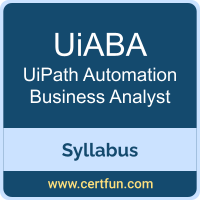 Use this quick start guide to collect all the information about UiPath UiABA Certification exam. This study guide provides a list of objectives and resources that will help you prepare for items on the UiPath Automation Business Analyst (UiABA) exam. The Sample Questions will help you identify the type and difficulty level of the questions and the Practice Exams will make you familiar with the format and environment of an exam. You should refer this guide carefully before attempting your actual UiPath Certified Professional Automation Business Analyst (UiABA) certification exam.
Use this quick start guide to collect all the information about UiPath UiABA Certification exam. This study guide provides a list of objectives and resources that will help you prepare for items on the UiPath Automation Business Analyst (UiABA) exam. The Sample Questions will help you identify the type and difficulty level of the questions and the Practice Exams will make you familiar with the format and environment of an exam. You should refer this guide carefully before attempting your actual UiPath Certified Professional Automation Business Analyst (UiABA) certification exam.
The UiPath UiABA certification is mainly targeted to those candidates who want to build their career in Business Analyst domain. The UiPath Certified Professional Automation Business Analyst (UiABA) exam verifies that the candidate possesses the fundamental knowledge and proven skills in the area of UiPath UiABA.
UiPath UiABA Exam Summary:
| Exam Name | UiPath Certified Professional Automation Business Analyst (UiABA) |
| Exam Code | UiABA |
| Exam Price | $300 (USD) |
| Duration | 90 mins |
| Number of Questions | 60 |
| Passing Score | 70% |
| Books / Training | Automation Business Analyst Professional Training |
| Schedule Exam | Pearson VUE |
| Sample Questions | UiPath UiABA Sample Questions |
| Practice Exam | UiPath UiABA Certification Practice Exam |
UiPath UiABA Exam Syllabus Topics:
| Topic | Details |
|---|---|
| Business case and technical validation |
- Describe intake mechanisms for automation pipeline creation (intake form, Automation Hub). - Use Business Case template to create a business case for process selected for automation. |
| Process analysis |
- Describe value metrics taxonomy (productivity, quality, risk, speed/agility, experience). - Describe and create the Agent Definition Document. - Agent Description - define and explain the concepts: agent story, functional requirements, business requirements, non-functional requirements, triggers. - Agent Solution - describe the concepts: system prompts, user prompts, context grounding, tools, guardrails, escalations. |
| Automation development and testing |
- Manage the automation change control process. - Analyze the proposed changes with stakeholders and apply the KRAC (keep/remove/add/change) approach. - Update the Process Design Document (PDD) to include request changes and the detailed step-by-step description for each change implementation. |
| UAT | - Dealing with new or unexpected scenarios in the UAT stage. |
| Core UiPath Solutions |
- Describe processes executed with the different robot types (attended, unattended, human-in-the-loop, OS robot availability). - Describe use cases of multiple products used jointly to solve business problems. - Describe UiPath Studio REFramework (code structure: Dispatcher, Performer + error and exception types). - Describe what UiPath Orchestrator is and does. - List the different types of logs in UiPath Orchestrator. - Actions - role in the platform. - Insights - role in the platform. - Test Manager - role in the platform. - Describe UiPath Assistant and its applications. - Describe and use Autopilot for Everyone (A4E) in the context of a Business Analyst. - Integration Service - role in the platform. - UiPath Apps - usage and role in the platform, document app mock-up and functions. |
| AI UiPath Solutions |
- Define what UiPath Document Understanding is. - Distinguish between structured, unstructured, and semi-structured documents that can be processed with Document Understanding. - Distinguish between types of data extraction methodology (Rule-based, Model-based). - Describe the number of samples needed to be processed with Document Understanding depending on document types. - Describe the Document Understanding framework. - Describe what UiPath AI Center is and explain how Specialized Models can be used in processes. - Define what Communications Mining is. - Describe the process of using Communications Mining as an end user. - Distinguish between Generative and specialized AI. - Describe the usage of computer vision. |
| Discovery UiPath Solutions |
- Define what Task Mining is and when it is suitable to use it. - Define what Process Mining is and when it is suitable to use it. - Define what Automation Hub is and when it is suitable to use it. |
| UiPath Implementation Methodology | - Outline the roles and responsibilities of a Business Analyst throughout a project implementation (automation and agentic). |
| UiPath Platform | - Describe UiPath Platform and deployment options (cloud, on-premises, hybrid). |
| Agentic |
- Explain what agentic automation is. - Differentiate between regular Automation and agentic automation and when to apply. - Describe Process Modeling in the context of Maestro. (BPMN). - Describe the agentic components and their interaction - context grounding, tools, escalations. |
To ensure success in UiPath UiABA certification exam, we recommend authorized training course, practice test and hands-on experience to prepare for UiPath Automation Business Analyst (UiABA) exam.
